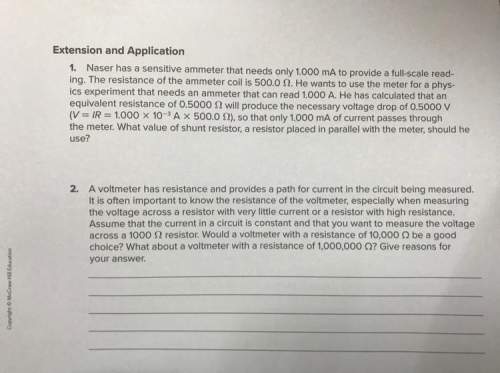
Physics, 20.02.2020 08:42 lebronjames1604
Point charges q1= - 4.30 nC and q2=+ 4.30 nC are separated by a distance of 3.00 mm, forming an electric dipole.
*Find the magnitude of the electric dipole moment. (C/m)
*Find the direction of the electric dipole moment? ( From q1 to q2 or From q2 to q1??)
*The charges are in a uniform electric field whose direction makes an angle of 36.9 degrees with the line connecting the charges. What is the magnitude of this field if the torque exerted on the dipole has magnitude 7.20×10^-9 N*m ? (N/C)

Answers: 2


Another question on Physics

Physics, 22.06.2019 04:00
Several mountains together form a mountain . a few of these combined form a mountain system. several systems combined form a mountain , which can stretch thousands of miles in length.
Answers: 2

Physics, 22.06.2019 05:30
Suppose you have three polarizing filters, with the second at an angle of 42∘ to the first and the third at an angle of 90∘ to the first. by what perfect will the original intensity of unpolarized light be reduced to after passing through all three filters?
Answers: 2

Physics, 23.06.2019 03:20
Neutrons are placed in a magnetic field with magnitude 2.30 t. part a part complete what is the energy difference between the states with the nuclear spin angular momentum components parallel and antiparallel to the field? δe δ e = 2.77×10−7 ev previous answers correct part b part complete which state is lower in energy: the one with its spin component parallel to the field or the one with its spin component antiparallel to the field? which state is lower in energy: the one with its spin component parallel to the field or the one with its spin component antiparallel to the field? parallel antiparallel previous answers correct part c part complete how do your results compare with the energy states for a proton in the same field (δe=4.05×10−7ev)? how do your results compare with the energy states for a proton in the same field this result is smaller than but comparable to that found in the example for protons. this result is greater than but comparable to that found in the example for protons. previous answers correct part d the neutrons can make transitions from one of these states to the other by emitting or absorbing a photon with energy equal to the energy difference of the two states. find the frequency of such a photon. f f = mhz previous answersrequest answer incorrect; try again; 5 attempts remaining
Answers: 2

Physics, 23.06.2019 03:30
An object is kept at 45 m high and how much time will it take to reach the ground
Answers: 2
You know the right answer?
Point charges q1= - 4.30 nC and q2=+ 4.30 nC are separated by a distance of 3.00 mm, forming an elec...
Questions

English, 23.10.2020 08:01

Social Studies, 23.10.2020 08:01

History, 23.10.2020 08:01




History, 23.10.2020 08:01


Mathematics, 23.10.2020 08:01



English, 23.10.2020 08:01

Mathematics, 23.10.2020 08:01

Mathematics, 23.10.2020 08:01

Social Studies, 23.10.2020 08:01

Mathematics, 23.10.2020 08:01


History, 23.10.2020 08:01


History, 23.10.2020 08:01




